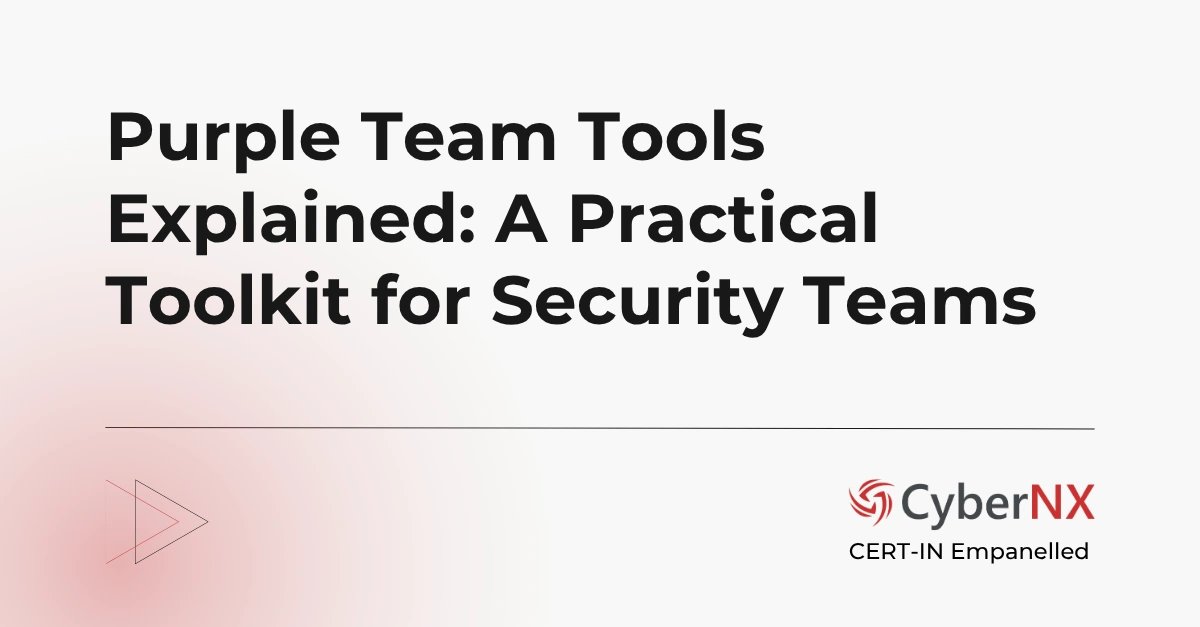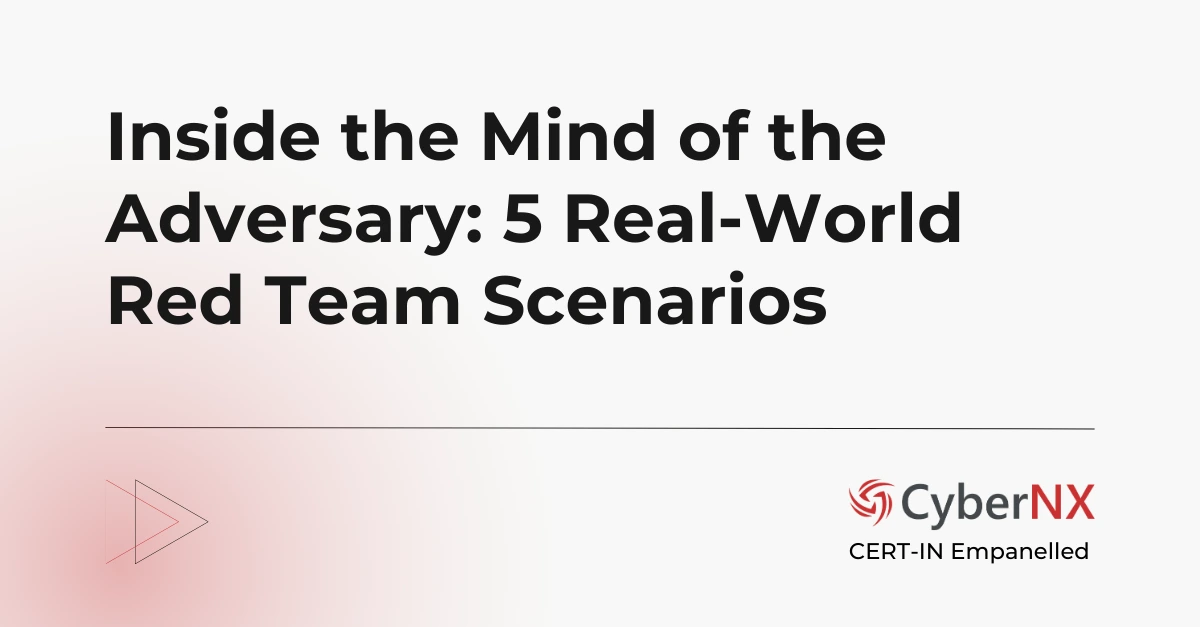There is an evolutionary shift happening across organizations, powered by digital transformation. However, people, processes and technology, continue to hold the key to safe and secure business growth.
In the age where cyber risks and threats are undisputedly damaging organizations, the digital ecosystem must be able to withstand unseen adversaries, everywhere and always.
A red teaming exercise has hence gained prominence among the security teams as an effective means to thwart attacks and respond to them efficiently.
Now this leads us to red teaming frameworks, which offers precisely the kind of strategic challenge: a simulated adversarial test, turned into insight and resilience. In this blog, our experts explore how the right red teaming framework can boost your security posture and brand’s credibility.
What is Red Teaming?
Red teaming is the practice of thinking like an adversary to test how well an organization can withstand real-world attacks. It’s about challenging assumptions, exposing weak points, and measuring how effectively your team detects and responds under pressure.
A red teaming framework provides structure to this process. It defines how attacks are planned, executed, and assessed. The goal is to strengthen strategy, sharpen response, and build lasting confidence in your defences. Learn more about in the next section.
What are Red Teaming Frameworks?
Red teaming frameworks can be understood as a set of processes or procedures which needs to be followed by organizations offering red teaming exercise.
So, if you have an in-house red team or depend on a third-party for offensive cybersecurity, there are some components which needs to be implemented.
Only the framework can make red teaming exercise a methodical, successful evaluation of the security posture of an organization.
A compelling red teaming framework includes:
- Orchestration of realistic, intelligence-led, real world attack simulations.
- Frames scope, risk tolerance and objectives in clear and actionable terms.
- Reveals weaknesses in people, process and technology, across the organization, not limiting to infrastructure.
- Provides valuable and contextual outputs tailored for easy boardroom discussion and executive buy-in.
Red Team Frameworks: Spotlight on Three Distinguished Frameworks
Find three red team frameworks often talked about in financial-sector red teaming:
| FRAMEWORK | ORIGIN / ISSUING BODY | HIGHLIGHTS |
| TIBER-EU | European Central Bank (via DNB) | Intelligence-based, harmonizes cross-border testing |
| AASE | Association of Banks, Singapore | Maturity-tailored, four-phase structure |
| CBEST | Bank of England & CREST | Covert, “control group” approach with legal rigor |
1. TIBER-EU: A Continental Standard, with Local Nuance
Established in the Netherlands and further adopted by the European Central Bank, TIBER-EU simplifies threat-intelligence driven attack scenarios for the financial services.
This red teaming framework standardizes how finance companies simulate attacks and enable mutual trust and cross-border consistency.
For CISOs and CTOs busy with mergers, multi-jurisdiction testing and brand elevation responsibilities in regulated markets, TIBER-EU is helpful. This red teaming framework is clearly a statement of continental rigor and institutional confidence.
2. AASE: Poised for Progressive Defences
Singapore’s AASE introduces a structured framework, tailored to achieve cybersecurity maturity. This methodology comprises of four phases Planning, Attack Preparation, Attack Execution and Closure. It offers clarity and stepping through each stage feels like your red teamers are going down the right path.
For CEOs championing security maturity and a measured path forward, AASE delivers that sophistication. And yes, it also stands out as an adaptable framework that does not overwhelm your teams.
3. CBEST: Confidential, Compliant and Commanding
Developed by the Bank of England in partnership with CREST, CBEST emphasizes secrecy, legal safety and concentrated oversight. Its control group model ensures tight governance. This feature is respected by CEOs, CTOs and boards. Opting for this framework signals that you value confidentiality as much as consequence-driven insight.
Conclusion
Choosing a red teaming framework is an executive decision with long-term strategic consequences. Each framework such as TIBER-EU, AASE or CBEST, represents a tested methodology for uncovering vulnerabilities that conventional assessments overlook. For leadership, the value lies in gaining validated, intelligence-driven insight that informs policy, investment and resilience planning.
By embedding red teaming into your organizational culture, you signal to stakeholders, regulators and the market that your commitment to security is deliberate. This elevates your risk governance maturity and strengthens trust.
Our CERT-In empanelled red teaming services can help your organization boost the security posture of your organization by exposing flaws, fixing gaps with valuable insights and strengthening the defence mechanisms. Contact us today to know more.
Red Teaming Frameworks FAQs
How is a red teaming framework different from a standard penetration test?
A penetration test focuses on finding and exploiting technical vulnerabilities in specific systems, often within a defined scope. A red teaming framework, by contrast, is broader and more strategic-it simulates real-world, multi-vector attacks, incorporating physical, technical, and social engineering tactics. The framework ensures the exercise follows a repeatable, intelligence-driven structure that can be benchmarked across time or industries.
Can a red teaming frameworks be adapted for industries outside finance?
Absolutely. While many well-known frameworks such as TIBER-EU and CBEST were designed for banking and financial services, the principles-threat intelligence, realistic adversary simulation, and structured reporting-can be tailored to sectors like healthcare, critical infrastructure, or technology. The key is aligning the framework with industry-specific threat landscapes and regulatory obligations.
How often should an organization apply a red teaming frameworks?
Frequency depends on factors such as your organization’s threat exposure, industry regulations, and rate of digital transformation. Many mature security programs conduct full red teaming exercises annually, supplemented by smaller, targeted simulations throughout the year. Using a consistent framework ensures results are comparable over time, making progress measurable and strategic decisions data-driven.
What role does executive leadership play in a red teaming exercise?
Executive buy-in is critical. Leadership defines the scope, sets acceptable risk thresholds, and ensures findings are integrated into broader business strategy-not just IT remediation plans. When the C-suite champions a red teaming exercise, it sends a clear message internally and externally: cybersecurity is a board-level priority and a fundamental pillar of organizational resilience.
Find out what else entails this cybersecurity approach with our comprehensive blog on Red Teaming Exercise.





